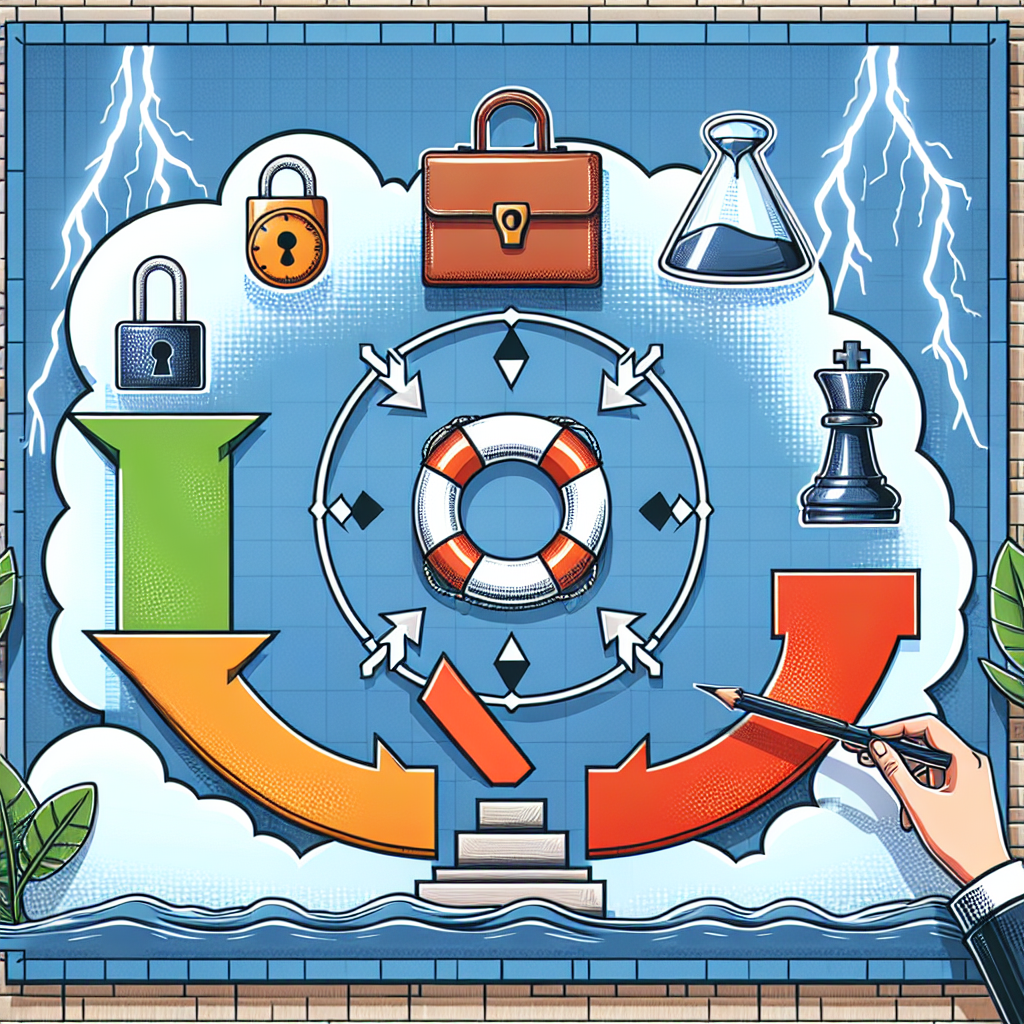Your cart is currently empty!
Tag: Continuity

5 Key Steps to Ensure Business Continuity in Times of Crisis
In today’s unpredictable business landscape, it is more important than ever for companies to have a solid plan in place to ensure business continuity in times of crisis. Whether it’s a natural disaster, a cyber attack, or a global pandemic, having a plan in place can mean the difference between a company surviving or shutting down.Here are 5 key steps to ensure business continuity in times of crisis:
1. Develop a Business Continuity Plan: The first step in ensuring business continuity is to develop a comprehensive business continuity plan. This plan should outline the steps that need to be taken in the event of a crisis, including who is responsible for what tasks, how communication will be handled, and what resources are available to the company.
2. Identify Critical Functions and Processes: In order to prioritize resources during a crisis, it is important to identify the critical functions and processes that are essential to the operation of the business. By focusing on these key areas, companies can ensure that they are able to continue operating even in the face of a crisis.
3. Implement Remote Work Policies: In times of crisis, it may be necessary for employees to work remotely in order to maintain business operations. Companies should have remote work policies in place that outline expectations for employees working from home, as well as provide the necessary technology and tools to enable remote work.
4. Test and Update the Plan Regularly: A business continuity plan is only effective if it is regularly tested and updated. Companies should conduct regular drills and simulations to ensure that employees are familiar with the plan and know what to do in the event of a crisis. Additionally, the plan should be updated regularly to reflect changes in the business environment and emerging threats.
5. Establish Communication Channels: Communication is key in times of crisis, both internally with employees and externally with customers and stakeholders. Companies should establish clear communication channels, such as a designated crisis communication team and a system for disseminating information quickly and efficiently.
By following these 5 key steps, companies can ensure that they are prepared to weather any crisis that may come their way. Business continuity planning is an essential part of risk management and can mean the difference between a company surviving a crisis or shutting down. It is never too early to start developing a plan and ensuring that your business is prepared for whatever the future may hold.

How Network Management Impacts Business Continuity and Disaster Recovery
In today’s digital age, businesses rely heavily on their network infrastructure to operate efficiently and effectively. From communication and collaboration to data storage and customer interactions, a company’s network plays a crucial role in its day-to-day operations. However, with the increasing complexity and interconnectedness of networks, the risk of downtime and data loss due to network failures or cyberattacks has also grown.This is where network management comes into play. Network management involves the monitoring, troubleshooting, and optimization of a company’s network to ensure its smooth and uninterrupted operation. It encompasses a range of tasks, such as network monitoring, performance management, security management, and configuration management, among others. By effectively managing their network infrastructure, businesses can not only enhance their operational efficiency but also mitigate the risks of network disruptions that could potentially lead to business downtime and financial losses.
One key aspect of network management that is closely tied to business continuity and disaster recovery is network monitoring. By continuously monitoring the network for performance issues, anomalies, and security threats, businesses can proactively identify and address potential problems before they escalate into major disruptions. This real-time visibility into the network enables IT teams to quickly respond to incidents, minimize downtime, and ensure the continuity of business operations.
Additionally, network management plays a critical role in disaster recovery planning. In the event of a natural disaster, cyberattack, or any other unforeseen event that disrupts the network, having a robust disaster recovery plan in place is essential for minimizing the impact on business operations. Network management tools and practices can help businesses create and maintain backups of their critical data, implement failover mechanisms, and establish alternate communication channels to ensure that the business can quickly recover and resume operations in the event of a network outage.
Furthermore, effective network management can also enhance the overall resilience of a company’s network infrastructure. By regularly monitoring and optimizing network performance, identifying and addressing vulnerabilities, and implementing robust security measures, businesses can reduce the likelihood of network failures and cyberattacks that could jeopardize business continuity. Investing in network management not only helps businesses maintain a reliable and secure network but also contributes to their overall resilience and ability to withstand unexpected disruptions.
In conclusion, network management is a critical component of business continuity and disaster recovery planning. By proactively monitoring and managing their network infrastructure, businesses can mitigate the risks of network disruptions, enhance their operational efficiency, and ensure the continuity of their business operations in the face of unforeseen events. Investing in network management tools and practices is essential for businesses looking to safeguard their network infrastructure and protect their bottom line.

The Importance of Business Continuity Planning: A Guide for Companies
In today’s fast-paced and unpredictable business environment, it is more important than ever for companies to have a solid business continuity plan in place. Business continuity planning is the process of creating a roadmap that outlines how a company will continue to operate during and after a disruptive event, such as a natural disaster, cyber attack, or pandemic.Having a business continuity plan can help companies minimize the impact of disruptions on their operations, employees, customers, and bottom line. By identifying potential risks and developing strategies to mitigate them, companies can ensure that they are prepared to respond quickly and effectively when a crisis strikes.
One of the key benefits of business continuity planning is that it helps companies maintain business continuity and ensure the uninterrupted delivery of products and services to customers. This can help companies maintain their reputation and customer loyalty, even in the face of a crisis.
Business continuity planning also helps companies protect their employees and assets. By having a plan in place, companies can ensure the safety and well-being of their employees during a crisis and minimize the loss of valuable assets.
Moreover, having a business continuity plan can also help companies comply with regulatory requirements and industry standards. Many industries require companies to have a business continuity plan in place to ensure that they can continue to operate in a safe and secure manner.
In addition, having a business continuity plan can help companies save time and money in the long run. By investing in proactive planning and preparation, companies can reduce the costs associated with responding to and recovering from a crisis.
Overall, business continuity planning is an essential component of a company’s risk management strategy. By taking the time to develop a comprehensive plan, companies can ensure that they are prepared to navigate any challenges that come their way and emerge stronger on the other side. It is important for companies of all sizes and industries to prioritize business continuity planning to protect their employees, assets, and reputation in the face of disruptive events.

From Crisis to Continuity: How to Safeguard Your Business Against Disruption
In today’s rapidly changing business landscape, disruptions can happen at any time and in any form. From natural disasters to cyber attacks, the potential threats to a business’s continuity are numerous and varied. As such, it is crucial for businesses to have a plan in place to safeguard their operations and ensure they can continue functioning in the face of adversity.One key aspect of safeguarding a business against disruption is to have a comprehensive crisis management plan in place. This plan should outline the steps that need to be taken in the event of a disruption, including who is responsible for what tasks, how communication will be handled, and what resources are available to help mitigate the impact of the disruption. By having a clear plan in place, businesses can ensure that they can respond quickly and effectively to any crisis that arises.
Another important aspect of safeguarding a business against disruption is to have redundant systems in place. This means having backup systems and processes that can be activated in the event that primary systems fail. For example, businesses should have backup data storage systems in place to ensure that critical information is not lost in the event of a cyber attack or other data breach. Similarly, businesses should have backup power sources in place to ensure that operations can continue even if there is a power outage.
In addition to having a crisis management plan and redundant systems in place, businesses should also regularly review and update their continuity plans to ensure they are still relevant and effective. This includes conducting regular risk assessments to identify potential threats to the business and developing strategies to mitigate those risks. By staying proactive and constantly assessing and updating their continuity plans, businesses can ensure they are prepared to handle any disruption that comes their way.
In conclusion, safeguarding a business against disruption requires a proactive approach and a comprehensive plan. By having a crisis management plan in place, implementing redundant systems, and regularly reviewing and updating their continuity plans, businesses can ensure they are prepared to weather any storm and continue functioning in the face of adversity. Ultimately, by taking these steps, businesses can safeguard their operations and protect their bottom line from the potentially devastating impact of disruptions.

Data Backup and Recovery: A Vital Component of Business Continuity Planning
In today’s digital age, businesses rely heavily on their data to operate efficiently and effectively. From customer information to financial records, data is the lifeblood of any organization. However, with the increasing threat of cyber attacks, natural disasters, and human error, data loss is a very real possibility. This is why data backup and recovery is a vital component of business continuity planning.Data backup involves creating copies of important information and storing them in a secure location. This ensures that if the original data is lost or compromised, it can be easily restored. There are various methods of data backup, including cloud storage, external hard drives, and tape backups. It is important for businesses to regularly back up their data to minimize the risk of data loss.
Data recovery, on the other hand, involves restoring lost or corrupted data from backups. This process can be time-consuming and costly, depending on the extent of the data loss. Having a solid data recovery plan in place is crucial for businesses to minimize downtime and prevent loss of revenue.
Business continuity planning is the process of creating strategies and procedures to ensure that a business can continue to operate in the event of a disruption. Data backup and recovery are key components of business continuity planning, as they help businesses recover quickly from data loss and resume normal operations.
There are several reasons why data backup and recovery are essential for business continuity planning. Firstly, data loss can result in financial loss and damage to a company’s reputation. For example, if a business loses customer data due to a cyber attack, it can lead to legal consequences and loss of trust from customers. Additionally, data loss can disrupt operations and result in downtime, which can impact productivity and revenue.
Having a solid data backup and recovery plan in place can help businesses mitigate the risks associated with data loss. By regularly backing up data and implementing robust recovery procedures, businesses can minimize the impact of data loss on their operations.
In conclusion, data backup and recovery are vital components of business continuity planning. By implementing a solid data backup and recovery plan, businesses can ensure that their critical information is protected and that they can quickly recover from any data loss incidents. Investing in data backup and recovery solutions is essential for any business looking to safeguard their data and maintain operational resilience.

Building Resilience: Why Business Continuity Is Essential for Long-Term Success
In today’s fast-paced and unpredictable business environment, building resilience is crucial for long-term success. One key aspect of resilience is business continuity planning, which involves preparing for and responding to potential disruptions that could impact the operations of a company. From natural disasters to cyber attacks, there are a myriad of threats that can jeopardize a business’s ability to function effectively. By implementing a comprehensive business continuity plan, organizations can mitigate risks, minimize downtime, and ensure that they are able to bounce back quickly in the face of adversity.One of the main reasons why business continuity is essential for long-term success is that it helps to protect a company’s reputation. In the event of a crisis, how a business responds can have a lasting impact on its brand and customer perception. By having a solid business continuity plan in place, companies can demonstrate their commitment to their customers, employees, and stakeholders by showing that they are prepared for any eventuality. This can help to build trust and loyalty, even in the face of challenges.
Business continuity planning also helps to safeguard a company’s bottom line. Downtime can be costly, both in terms of lost revenue and potential damage to a company’s financial health. By having a plan in place to quickly resume operations after a disruption, businesses can minimize the impact on their finances and maintain business continuity. This can help to ensure that the company remains profitable and competitive in the long run.
Furthermore, business continuity planning can also help to protect a company’s employees and assets. By having protocols in place to ensure the safety and security of staff and resources during a crisis, organizations can minimize the risk of harm and damage. This can help to ensure the well-being of employees and protect valuable assets, such as data and equipment, which are essential for the continued success of the business.
In conclusion, building resilience through business continuity planning is essential for long-term success in today’s volatile business landscape. By preparing for potential disruptions and having a plan in place to respond effectively, companies can protect their reputation, finances, and resources, ensuring that they are able to weather any storm and emerge stronger on the other side. Investing in business continuity is an investment in the future of the company, and a key component of a successful long-term strategy.

Managed Service Providers: A Key Player in Business Continuity and Disaster Recovery
In today’s digital age, businesses are more reliant on technology than ever before. From storing important data to communicating with customers, technology plays a crucial role in the day-to-day operations of companies large and small. However, with this increased reliance on technology comes the potential for unexpected disasters that can disrupt business operations and put sensitive data at risk.This is where Managed Service Providers (MSPs) come in. MSPs are companies that provide IT services and support to businesses on an ongoing basis. They help companies manage their technology infrastructure, monitor for potential issues, and provide support when problems arise. One of the key services that MSPs offer is business continuity and disaster recovery planning.
Business continuity and disaster recovery planning is essential for businesses to ensure that they can continue to operate in the event of a disaster, such as a cyber attack, natural disaster, or hardware failure. MSPs play a crucial role in helping businesses develop and implement a comprehensive plan to minimize downtime and data loss in the event of a disaster.
MSPs work with businesses to assess their current IT infrastructure and identify potential risks and vulnerabilities. They help businesses develop a plan that outlines how data will be backed up, how systems will be restored, and how operations will be maintained in the event of a disaster. MSPs also provide ongoing monitoring and support to ensure that the plan remains up-to-date and effective.
In addition to helping businesses develop a disaster recovery plan, MSPs also provide the technology and resources needed to implement the plan. This includes technologies such as cloud backup and recovery solutions, virtualization, and secure data storage. MSPs also provide 24/7 support to quickly address any issues that arise during a disaster.
By working with an MSP to develop a business continuity and disaster recovery plan, businesses can ensure that they are prepared for any unexpected event that could disrupt their operations. MSPs help businesses mitigate risks, minimize downtime, and protect sensitive data, ultimately helping them maintain business continuity and recover quickly from a disaster.
In conclusion, Managed Service Providers are a key player in business continuity and disaster recovery. By partnering with an MSP, businesses can have peace of mind knowing that they have a comprehensive plan in place to protect their data and ensure that they can continue to operate in the face of any disaster. With their expertise and support, MSPs help businesses navigate the complexities of IT disaster recovery and ensure that they are prepared for any unexpected event.

The Future of Business Continuity: Trends and Technologies to Watch
Business continuity is a critical aspect of any organization’s strategy for ensuring that operations can continue in the face of unexpected disruptions. As technology evolves and new challenges emerge, the future of business continuity is constantly evolving. Here are some key trends and technologies to watch in the coming years.1. Cloud-based solutions: The cloud has revolutionized the way businesses operate, offering increased flexibility, scalability, and cost-effectiveness. Cloud-based business continuity solutions are becoming increasingly popular, allowing organizations to store data and applications off-site and access them in the event of a disaster.
2. Artificial intelligence and machine learning: AI and machine learning technologies are being used to enhance business continuity planning and response. These technologies can analyze vast amounts of data to predict potential disruptions and automate response processes, helping organizations to minimize downtime and recover more quickly.
3. Internet of Things (IoT): The IoT is connecting devices and sensors to the internet, providing real-time data on everything from equipment performance to environmental conditions. This data can be used to improve business continuity planning by identifying vulnerabilities and predicting potential disruptions before they occur.
4. Cybersecurity: Cyber attacks are a major threat to business continuity, with hackers constantly seeking to disrupt operations and steal sensitive data. As cyber threats evolve, organizations must invest in robust cybersecurity measures to protect their systems and data.
5. Remote work solutions: The COVID-19 pandemic has accelerated the shift towards remote work, highlighting the importance of ensuring that employees can work effectively from anywhere. Business continuity plans must now include provisions for remote work, including secure access to company systems and data.
6. Blockchain technology: Blockchain technology offers a secure and transparent way to store and share data, making it ideal for ensuring the integrity of critical information during a disruption. By leveraging blockchain technology, organizations can enhance the security and resilience of their business continuity plans.
7. Data analytics: Data analytics can provide valuable insights into business operations, helping organizations to identify trends and patterns that may impact continuity. By analyzing data from various sources, organizations can make more informed decisions and proactively address potential disruptions.
In conclusion, the future of business continuity is evolving rapidly, driven by advancements in technology and changes in the business landscape. By staying abreast of these trends and technologies, organizations can better prepare for and respond to disruptions, ensuring that their operations remain resilient and sustainable in the face of uncertainty.

Case Studies in Business Continuity: Lessons Learned from Real-World Disasters
Business continuity planning is essential for organizations to ensure that they are able to recover from disruptions and continue operations in the event of a disaster. Case studies of real-world disasters can provide valuable insights into the importance of effective business continuity planning and the lessons that can be learned from these incidents.One such example is the case of Hurricane Katrina, which struck the Gulf Coast of the United States in 2005. The storm caused widespread destruction and resulted in the displacement of thousands of people. Many businesses in the affected areas were forced to shut down temporarily or permanently due to the damage caused by the hurricane.
One of the key lessons learned from Hurricane Katrina is the importance of having a comprehensive business continuity plan in place. Organizations that had robust plans in place were able to recover more quickly and resume operations sooner than those that did not. This highlights the importance of conducting risk assessments, developing contingency plans, and regularly testing and updating these plans to ensure that they are effective in the event of a disaster.
Another example of a real-world disaster that can provide valuable insights into business continuity planning is the 2011 earthquake and tsunami in Japan. The disaster caused widespread damage to infrastructure and disrupted supply chains, leading to significant challenges for businesses operating in the affected areas.
One of the lessons learned from the Japan earthquake is the importance of having a resilient supply chain. Organizations that had diversified supply chains and contingency plans in place were better able to mitigate the impact of the disaster and continue operations. This underscores the importance of conducting risk assessments, identifying critical suppliers, and developing alternative sourcing strategies to ensure business continuity in the event of a disruption.
In conclusion, case studies of real-world disasters can provide valuable insights into the importance of effective business continuity planning and the lessons that can be learned from these incidents. By studying these cases and implementing best practices in business continuity planning, organizations can better prepare for and recover from disasters, ensuring the resilience and sustainability of their operations in the face of adversity.

